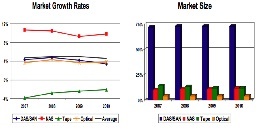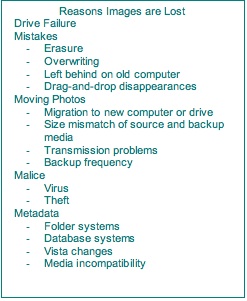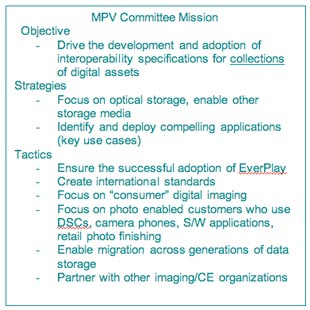November 2007
.
Optical Storage
News
Table of Contents
- Optical Storage Symposium 2007 Highlights
- Market Perspectives on the Data Storage Industry
- Photo Archiving: Where Have All Your Digital Photos Gone?
- High Capacity Optical Storage – Will Blue Laser or Holographic Storage Be the Solution?
- New Technology Roundtable – Very Large Scale Optical Recording
- OSTA December Quarterly Meetings
- MPV Mission and Upcoming Meeting
- Join Others Interested in Archival Storage at COSA’s December Meeting
- On the Horizon, by David Bunzel, President Archivemyphotos.org Goes Live; In Praise of Optical Storage
OSS 2007 Highlights
OSTA’s sixth annual Optical Storage Symposium featured valuable panel discussions from reflections on the current optical market to the importance of photo back up, and on to new and future recording technologies. Summaries of the four main panels are provided in this newsletter, and many of the presentations are available for download at http://www.osta.org/oss/agenda.htm.
Market Perspectives on the
Data Storage IndustryThis panel, with representatives from IBM Storage, NPD Group, SanDisk and NetApp, addressed major storage market concerns including the phenomenal growth of data to be stored; the critical nature of archiving data and disaster recovery, and key issues including compliance, data security and managing TCO and energy costs. The panel also reviewed the market outlook for disk drives, optical storage, NAND flash, and opportunities for optical storage in archival applications. (Read more)
Photo Archiving: Where Have All
Your Digital Photos Gone?With the transition to digital photography, the use and storage of photo images has changed dramatically. This panel discussed alternatives available to protect users’ photo collections. Photos are no longer saved in a shoebox or an album, but typically on someone’s computer. The HDD is the main repository for digital images, but few users understand the vulnerability of
this technology and that their whole photo collection can disappear in an instant if the hard drive fails. Photo archiving is a concept the industry needs to understand and end users need to embrace. The panel discussed best practices for archiving, including services for consumers that will create archival DVDs (or other media) from prints or digital image and video files. (Read more)
High Capacity Optical Storage –
Will Blue Laser or Holographic Storage be the Solution?
A new chapter for optical may be opening with the commercialization of blue laser formats and holographic storage, as well as a new wave of optical systems featuring library and RAID type options. The panel discussed market drivers and applications, a market review of today’s consumer and professional storage alternatives, and an in-depth review of current and future high capacity optical technology. For a summary, click here. The information-packed presentation can be downloaded from the OSTA website at http://www.osta.org/oss/pdf/presentations07/Johnson.pdf
New Technology Roundtable
This panel discussed the next big wave of optical recording technology providing very large-scale recording capability. Executives representing upcoming technologies gave an overview of their innovations, which are designed to deliver from hundreds of gigabytes to terabytes of data in single disk or other novel compact configurations. Also find out about the
The coming wave of very large-scale optical recording
next innovation of applying recordable DVD technology in a way that will impact all of us as consumers.
Emerging technologies featured included:
Maxell Corp.’s Stacked Volumetric Optical Discs (SVOD) - New large capacity optical disk cartridges for archival data storage. Planned products include a 1TB Blue laser SVOD using 20 discs @ 50GB per disc in a 5.25-inch cartridge and 5TB Blue laser SVOD using 100 discs @50GB per disc. (Maxell presentation)
MemPile’s TeraDisc Technology - a two-photon, high-density optical storage medium and drive technology enabling >1TB cost-effective and durable archiving storage on a 120mm disc. The roadmap calls for 500GB, 1TB and 5TB capacities on a single TeraDisc™. (MemPile presentation)
InPhase Tapestry™300r – A 300GB holographic video disc recorder that emulates MO WORM and LTO Tape drives that the company is promoting as the world’s first commercial holographic drive. (InPhase presentation)
IntelligentDisc, Inc.’s All in One PC on an Optical Disk, a rewritable volume on a bootable optical disk. Provides very high security optical storage for enterprise, government, military and medical applications.
(IntelligentDisc presentation)
OSTA Dec. Quarterly Meetings
The next OSTA meetings will take place at the Embassy Suites in South San Francisco, on Monday, Tuesday & Wednesday, December 3-5th, 2007. (Detailed schedule.)
MPV Mission and Dec. Meeting
The focus of the meeting will the 1) the EverPlay License Program and 2) completion of the MPV Print Profile.
For further information on the recently updated MPV Committee Mission, continue to the detailed schedule.Join Others Interested in Archival Storage at COSA’s December Meeting
The Commercial Optical Storage Applications committee will resume its quarterly meeting schedule on Dec. 4 at 1:30 p.m. at the Embassy Suites Hotel in South San Francisco. Graham Irving, from K-PAR Archiving Software, will serve as the new interim chairman. COSA’s charter is to promote storage solutions that incorporate optical storage technology to meet the growing need for regulatory compliance with regards to long-term data retention and/or in a non-alterable format; provide education and information about compliance storage technologies to the industry,resellers and end user customers; explain how these technologies operate; define the integration process that enables its use, and provide growth and development in markets for automated storage technology. If you’re interested in this important market segment, please join us on Dec. 4.
Archivemyphotos.org goes live
to help end users protect photos
David Bunzel, OSTA President
We’re happy to report that a new website resulting from the Photo Archiving Roundtable’s outreach efforts is up and running. <Archivemyphoto.org> provides FAQs on the risks of losing digital photos that haven’t been protected, and provides convenient, best practices for archiving photos and creating family albums using optical discs. A related viral marketing campaign, “Saving the Family Album” is in the initial rollout phase in New York grammar schools. Students creating digital albums will help spread the message about archiving photos to their families.
Today, OSTA has multiple activities underway to address the critical issues of data archiving. In addition to the work of the Photo Archiving Roundtable, the ODAT Committee has made significant progress in its efforts to define an industry-wide test methodology for archival grade optical media, and the COSA Committee provides information on archiving with optical storage in various industry segments such as medical, government, and legal that must meet compliance requirements.
In closing, I’d like to bring a very positive case study on optical storage to your attention. Byte and Switch recently published an article, “In Praise of Optical Storage,” saying “it may pay for users to look beyond [disk and tape] technologies to optical disc. Such was the case for the South Central Veterans' Administration Healthcare System in the aftermath of the hurricane Katrina devastation in New Orleans in late August 2005.
David Bunzel, President
(408) 253-3695
(408) 253-9938 FAX dbunzelosta.org
Optical Storage Technology Association
19925 Stevens Creek Blvd.
Cupertino, CA 95014 USA
Visit OSTA on the web at www.osta.orgNewsletter Editor
Jan Johnson
Multipath Communications
janmultipathcom.com
Market Perspectives of the Data
Storage IndustryThis session, moderated by Parker Lee, included representatives from IBM Storage, NPD Group, SanDisk and NetApp. A brief summary of key discussion points follows; more detail is available on the OSTA website at http://www.osta.org/oss/agenda.htm.
Major Storage Business Concerns:
- Data growth of up to 100% yearly
- Over 160 billion gigabytes created last year
- Data archive and disaster recovery are critical
- Compliance, data security and managing TCO and energy costs are key issues
- Optical growth rates are projected to be slightly below storage market average
- Disk storage is a performance choice; tape is a cost choice. Optical is a compromise with better cost than disk, and better performance than tape. For large enterprise customers, the typical solution is combined disk and tape. For consumer and small business, disk and optical are the choice.
Stephen Baker, Vice President, Industry Analysis, NPD Group, presented market research findings on the optical storage market:
- There is declining consumer interest in current CD/DVD optical technologies, and high definition alternatives are not yet a factor in the market.
- Next-generation DVD remains a difficult sell to U.S. customers; awareness among consumers of high definition options is about 20%
- Consumers show relatively little interest in DVD recording
- Consumer adoption of next-generation optical is dependent upon adoption of HDTV.
Stephen Manley, Chief Architect, Data Protection and Retention, NetApp noted the following trends:
- Disk drives are getting bigger, although performance is not improving significantly
- Ten years ago, 4GB drives were shipping; now petabyte systems are being assembled in enterprises.
- Although it’s less expensive to store any given byte on alternate storage technologies, ease of use has spurred disk-to-disk archiving.
- Consumers like to have services handle their archiving
Jonathan Hubert, Director, Strategic Marketing, SanDisk, presented key application and market drivers for flash:
- Drastic decline in NAND flash prices is driving both current and new applications
- A transition to multi-level cell technology is further reducing cost-per-bit for flash
- Digital imaging is still a growth driver for NAND flash
- Emerging opportunities in the PC for NAND flash include solid state drives, hybrid-HDD, nonvolatile system cache and add-on Windows Vista Performance (ReadyBoost)
Market Characteristics
Source: IBM
Photo Archiving: Where Have All Your Digital Photos Gone?
With the transition to digital photography, the ways people use and store photo images have changed dramatically. This session, moderated by Melissa Perenson, senior editor, PC World, with panelists Alexis Gerard, CEO, Future Image; John Christopher, Senior Data Recovery Engineer, DriveSavers Data Recovery; Tony Stieber, Business Development Manager, Digital Photography, Hewlett-Packard Company; Mitch GoldStone, President and CEO, scanmyphotos.com; and Greg Ayers, COO, YesVideo, included a discussion of some of the critical issues in digital photography and what alternatives are available to protect consumers’ photo collections.
Photos are no longer saved in a shoebox or an album, but typically on someone’s computer. The HDD is the main repository for digital images, but few users understand the vulnerability of this technology and that their whole photo collection can disappear in an instant. Photo archiving is a concept the industry needs to understand and end users need to embrace.
An IDC Digital Imaging Solutions and Services consumer survey forecasts the number of images worldwide captured by digital still cameras will increase from 172 billion in 2006 to 333 billion in 2010, and showed that on average, 67 percent of images captured are archived. In 2006, 290.3 billion GB of archived images were stored on PC HDD, 144.3 billion GB on optical drives, 91.7 billion GB on removable HDD, 60.2 billion GB are archived on the Internet and 58.2 billion GB on memory cards. By 2010, optical is projected to remain the second largest archival storage category, reaching an archived image capacity that year of 306.6 billion GB.
Panelists discussed best practices for photo archiving including backup to HDD and archiving to another HDD and optical, according to one panelist. Another panelist recommended keeping two archival copies in different locations. Although consumers are most aware of the possibility of drive failure, many things can go wrong, including accidental erasure, overwriting, and photos “left behind” when migrating to a new computer or drive.John Christopher, from DriveSavers Data Recovery noted that typically 90 percent of failed drives can be recovered, but recounted multiple stories of heartbroken consumers who lost photos from once in a lifetime events when a failed drive couldn’t be recovered.
Optical storage, particularly DVDs, offer a versatile, flexible, inexpensive medium to archive images as wells as enable them to be played back on either the TV or a PC.
For consumers who don’t want to archive photos themselves, services are available including scanmyphotos.com that will archive photos for consumers on DVD, and YesVideo, which will index and organize photos by scene change, and make an MPEG movies from consumers’ photos and video, to name a few.
More information is available for download in the panelists’ presentations at http://www.osta.org/oss/agenda.htm.
High Capacity Optical Storage –
Will Blue Laser or Holographic
Storage be the Solution?This session, moderated by Michael Johnson from CUC Broadcast, included panelists Graham Irving, K-PAR Archiving; Andy Richards, Plasmon Data; and Horst Schelling, Disc LLC. Optical storage has not been able to realize its full potential in large-scale storage applications despite offering some compelling attributes. A new chapter for optical may be opening with the commercialization of blue laser formats and holographic storage, and a new wave of optical systems featuring library and RAID type options. The panel discussed high capacity optical storage, from market drivers and applications, to a market review of consumer and professional storage alternatives, and on to an in-depth review of current and future high capacity optical technology. The accompanying information-packed presentation that can be downloaded from the OSTA website at http://www.osta.org/oss/pdf/presentations07/Johnson.pdf.
Professional grade optical storage is needed for archival applications, driven by the exponential growth of digital data that is now being created, captured and replicated. However, the market drivers for optical storage have typically been consumer-oriented products. IDC projects six-fold growth from 161 exabytes (161 billion gigabytes!) in 2006 to 988 exabytes by 2010. The majority of digital data growth will be generated from 1 billion plus devices including digital cameras, camera phones, medical scanners and surveillance cameras. Major growth drivers include digital image capture, analog to digital voice, analog to digital TV, the Internet, archival of email and instant messages, and significant growth in information compliance.
Holographic storage is an excellent solution for archiving that brings the areal density of optical into the range (or beyond) that of HDDs. Key applications for archival storage are healthcare, financial, government and legal, and broadcast and publishing of digital content, including video. Holographic storage also meets the archival requirements of permanence, authenticity, fast retrieval and removable media, with an attractive total cost of ownership.
Briefly, holographic storage uses a photo-polymer-based media like photography, only with a laser light source. One major difference from current optical storage is that holographic can store as much as 1.4 million bits per pulse, depending on the implemention.
The panel’s technology review addressed the roadmap for next-generation optical storage technology, which projects that fourth-generation optical discs, including multi-layer 2-beam absorption technology and holographic solutions will reach 1 terabyte between 2011 and 2016. An update on laser technology, and a technology review of HD DVD/Blu-ray, UDO and holographic solutions currently in development were presented, along with a review of three new Holographic Video Disc standards approved in 2007 by EMCA.
The panel’s final analysis of market prospects for high capacity optical storage is summarized below:
Blu-ray, to date, is targeting the consumer market
- Selected by entertainment, surveillance and VOD industries
- Cost-effective for archive applications, but has a slow adoption rate
- Little or no marketing in non-video markets
- Opportunities with technology partnering?
UDO is a mature technology with market penetration
- It is the most reliable long-term archival storage medium to date
- It could benefit from increased marketing, and additional OEM partners
- Needs competitive pricing to keep pace with Blu-ray in IT archival markets
Tapestry holographic is still in “beta”
- Will need 12-18 months in the market,
- Will media meet long-term archival storage requirements?
- Additional OEM and technology partners?
HVD appears very promising
- When?
- How much?



